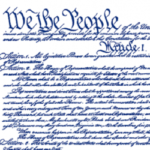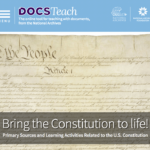C-SPAN’s Constitution Clips makes the U.S. Constitution come alive by providing teachers and students with video clips from C-SPAN’s Video Library of the Constitution in action.
Constitution of the United States with Index and the Declaration of Independence, Pocket Edition

This is the 25th pocket edition of the complete text of two core documents of American democracy, the Constitution of the United States (with amendments) and the Declaration of Independence. The resolution calling for the ratification of Constitutional Convention is also included. A topical index to the Constitution is provided. (House Document 112-29, 2012)
Bring the Constitution to Life!

Locate primary sources from the holdings of the National Archives related to such topics as “checks and balances,” “representative government,” all 27 amendments, and other concepts found in the Constitution. This special home page devoted to the U.S. Constitution also features activities to share with students, such as “The Constitution at Work,” which uses primary sources to demonstrate the Constitution in action in our everyday lives.
Making Civics Real
A multimedia workshop for high school civics teachers. It includes 8, 1-hour video programs, a print guide to the workshop activities, and a website. The goal of this workshop is to give teachers new resources and ideas to reinvigorate civic education. The series presents authentic teachers in diverse school settings modeling a variety of teaching techniques and best practices in a variety of social studies courses from a 9th-grade government/civics/econ course, to a 12th-grade law course
Our Constitution
The Our Constitution book, written by Donald A. Ritchie and JusticeLearning.org, takes an in-depth look at the Constitution, annotated with detailed explanations of its terms and contents. Included are texts of primary source materials, sidebar material on each article and amendment, profiles of Supreme Court cases, and timelines. The complete book or individual chapters can be downloaded.
Voices of History
Voices of History is a collection of eight Bill of Rights Institute curriculum resources including Being An American, Preserving the Bill of Rights, Founders and the Constitution, Supreme Court DBQs, Liberty and Security in Modern Times, Religious Liberty: An American Experiment, and Heroes and Villains. Teachers will have free access to each resources’ lessons plans and handouts.
14th Amendment: Battles for Equality
The 14th Amendment wrote the Declaration of Independence’s promise of freedom and equality into the Constitution. It transformed the Constitution forever. And it’s at the heart of what many scholars refer to as America’s “Second Founding.” Even so, the 14th Amendment is the focus of many of the most important constitutional debates (and Supreme Court cases) today. In many ways, the history of the modern Supreme Court is really a history of modern-day battles over the 14th Amendment’s meaning. Nearly every constitutional case that you care about today turns on the 14th Amendment.
The Bill of Rights
In this series of videos, students will hear from constitutional scholars such as Professor Tracey Meares of Yale University, Professor Orin Kerr of George Washington University, Dean Erwin Chemerinsky of Berkeley Law, and Michael McConnell, the director of the Stanford Constitutional Law Center. In these videos, two scholars discuss their interpretations of the amendments, often giving different points of view and interpretations.
The Bill of Rights in Modern Times
In this lesson, students will learn about the individual rights that are included in the Bill of Rights and current issues relating to them. Students will use C-SPAN Classroom’s Constitution Clips to explore what each of these rights mean and determine how these rights apply to current events in America. This lesson works well with classes with one-to-one devices or in flipped classrooms.
Colonial Influences (Lesson Plan and Powerpoint)
American colonists had some strong ideas about what they wanted in a government. These ideas surface in colonial documents, and eventually became a part of the founding documents like the Declaration of Independence and Constitution. But where did they come from? This lesson looks at the Magna Carta, Mayflower Compact, English Bill of Rights, Cato’s Letters and Common Sense.